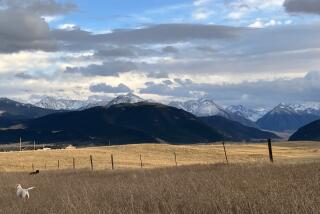Census Shows Midwest Towns in ‘Death Spiral’
The class of 2001 in the tiny town of Morland, Kan., is small enough to fit at a card table. When the four seniors graduate this spring, it will mark a beginning for them--and an end for their high school.
Morland High School--with 19 students--will hand out its diplomas in May, then close its doors days later, one more casualty of declining population in the more remote, rural towns of the nation’s heartland.
“Some people are angry, some people are sad,” says 27-year-old Principal Shelly Swayne, who grew up in a nearby northwestern Kansas town that lost its high school decades ago. “It’s hard for us to see beyond our own boundaries. We see this as a single phenomenon happening to us. But it’s a lot bigger than we are.”
It sure is.
The 2000 census confirmed long-held suspicions: Many small towns in isolated stretches of the Midwest and Great Plains are withering away.
Schools are closing, farmers are giving up and young people are moving out, leaving behind the elderly in communities struggling to keep their names on the map.
The latest census numbers show that dozens of counties in South Dakota, North Dakota, Missouri, Nebraska, Kansas, Iowa and Illinois lost people in the 1990s. The decline came even as these states gained population; one of the biggest surges came from the influx of Hispanics, lured by work in meat-packing and poultry plants and other hard-to-fill jobs.
Cities grew and suburbia expanded into once-rural areas as farmland was plowed over to make way for housing subdivisions. In Indiana, for instance, Hamilton County, next to Indianapolis, grew 68% over the last decade.
But deep in the reaches of the Midwest and Great Plains, the century-long slide in population continues, as it does in other parts of rural America. In the last decade, according to the census:
* About half of South Dakota’s 315 towns had no growth or fewer people.
* All but six of North Dakota’s 53 counties lost residents.
* A dozen rural Kansas counties lost 10% or more of their population.
* The number of residents 17 and younger declined in 63 of 99 Iowa counties.
“It ends up being sort of a death spiral,” says John Bailey, director of the rural policy program at the Center for Rural Affairs in Nebraska. “As communities get smaller, their schools, churches and business fade away. There’s nothing to draw people to live there. These towns are on the ropes now. In another generation, they could disappear.”
Many young people already “take the first bus out of town,” Bailey says. “Unless they go to work for their parents in a farm or ranch, there’s no economic opportunity for them. They either go to college and never return or go to one of the big population centers.”
Take Robbie Ellis.
One of Morland High’s last graduates, she will study accounting this fall at college in Colby, Kan., 56 miles from home. After that, she is uncertain.
“I want to drift around until I find the best job,” the 18-year-old says. “It might or might not be Kansas.” If it is, she says, it will not be in a small town, because there is no work there.
This kind of brain drain has long-range implications, says Paul Lasley, professor of sociology at Iowa State University.
“Not only do you lose well educated young people who are going to become parents, but you lose the next generation putting down roots,” he says. “What we really are seeing is a leadership void in a lot of those communities. Who’s going to be the future leaders?”
It is a question Joseph Kingsley might be asking himself.
Kingsley has been town council president in Laconia, Ind., for 26 of his 69 years. Over the decades, he has seen the closing of his high school, grocery stores, restaurants and the pool hall.
The census recently reported that his southern Indiana town had dwindled from a population of 75 in 1990 to 29 in 2000.
“It’s going down right smart,” Kingsley says. “We don’t have no young ones staying on anymore. Half the residents here are old women--75 to 80 years old.”
Kingsley has been working to get approval for a new sewer system, hoping it will attract business. But, he says, “Every time you go somewhere for money, they say you ain’t got enough people. That’s the excuse they use.”
Kingsley left Laconia for just two years--to serve in Korea.
“I stayed here so long,” he says, “I guess I never got a chance to get away.”
David Hansen did. But the 63-year-old retired United Methodist minister who grew up on a farm returned 20 years ago to grow grain and raise cattle and sheep on 320 acres of sandy, loamy soil in central Nebraska.
As a minister and a farmer, he has witnessed the fading fortunes of small-town America.
For 14 years, he was a traveling pastor to three small congregations in Blaine County, and they all shrank by a third. As a farmer, he has become a lonelier figure on the land. He knows of a dozen area farmers who have quit in the past two decades.
“It’s not a good feeling to lose neighbors,” he says. “I guess you have to accept the change. There’s some sense you cannot go back and recreate the past.”
At Morland High, Shelly Swayne and her students are looking ahead. Most of the students will transfer to a school 12 miles away.
Swayne says if circumstances were different, she might have remained at Morland most of her career. She enjoys walking to work, feeling secure at home, striking up a conversation with anyone she meets at the corner grocery.
“I want to stay here,” she says. “But there’s no reason for me to stay.”
“I’ll polish the resume and find a job somewhere else,” she adds. “It’s going to have to be a bigger school. I don’t really have a choice.”
“I’ll go away,” she says. “But I’ll probably end up coming back.”
*
Census Bureau: www.census.gov
More to Read
Sign up for Essential California
The most important California stories and recommendations in your inbox every morning.
You may occasionally receive promotional content from the Los Angeles Times.










